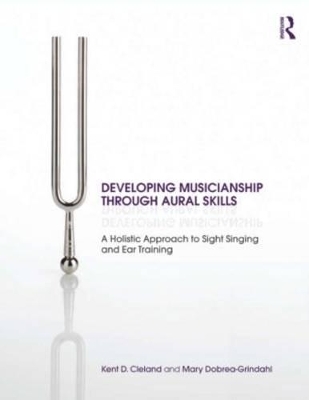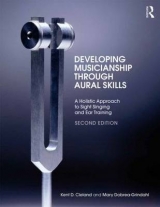
Developing Musicianship Through Aural Skills
Routledge (Verlag)
978-0-415-80244-4 (ISBN)
- Titel erscheint in neuer Auflage
- Artikel merken
Developing Musicianship Through Aural Skills is a comprehensive method for learning to hear, sing, understand, and use the foundations of music as a part of an integrated and holistic curriculum for training professional musicians.
Each chapter is organized to take advantage of how our minds and instincts naturally hear and understand music and provides a variety of exercises for practicing and integrating the structure into your musical vocabulary. Developing Musicianship Through Aural Skills will provide you with the musical terms, progressions, resolutions, and devices that you will be able to draw upon as a functional and usable musical vocabulary. Ear training exercises on the companion website reinforce both discrete structures (intervals, chords, etc.) as well as all rhythmic and melodic material, and sections are provided to open discussion and reflection on the skills and attitudes professional musicians need to be successful.
Features:
Easy to Understand Explanations: Topics are logically ordered and explained to help the student make connections to their theory instruction and common usage.
A Complete Method: Detailed instructions are given for singing and hearing structures as they most commonly appear in music., providing students with a proven, reliable process for creating and discerning musical structures.
Exercises: Ideas for drill, pitch patterns, rhythms, melodies, duets, sing and plays, and examples from the literature help the student to integrate each chapter’s material.
Reflections: Discussions of topics that help students to develop as a person, a professional, and an artist, and to integrate aural skills into their musical education.
Companion Website: Ear Training tools and video demonstrations. You can find the companion website at www.routledge.com/textbooks/developingmusicianship.
Kent D. Cleland is an Associate Professor and Chair of the Department of Music Theory at the Baldwin-Wallace College Conservatory of Music. He holds degrees from Ohio University, Indiana University, and the University of Cincinnati, and he has taught at the University of Cincinnati and Oberlin College. Mary Dobrea-Grindahl holds the Diplôme Jaques-Dalcroze from the Institute Jaques-Dalcroze in Geneva, Switzerland. She is an Associate Professor of Piano and Chair of the Keyboard Department at the Baldwin-Wallace College Conservatory of Music, where she teaches private piano, pedagogy, Eurhythmics, and solfège.
Preface 1. Simple Meter, Rests and Phrases; The Major Mode, Major Triads and Tonic Function 2. Compound Meters, Ties and Dots; The Minor Mode, Inverted Triads 3. Changing Meter; The Dominant Sound 4. Triplets and Duplets; Seventh Chords and Predominant Function 5. Less Common Meters; C Clefs and Harmonic Progression 6. Syncopation; Beginning Non-Modulating Chromaticism 7. Triplets and Duplets; More Non-Modulating Chromaticism 8. Triplets; Other Clefs; Beginning Modulation 9. Reading Complex Rhythms; More Complex Modulation 10. Twentieth Century Rhythmic Techniques 11. Twentieth Century Material based on Tonal Models 12. Twentieth Century Material based on Non-Tonal Models 13. Appendices
| Erscheint lt. Verlag | 31.3.2010 |
|---|---|
| Zusatzinfo | 1821 Line drawings, black and white |
| Verlagsort | London |
| Sprache | englisch |
| Maße | 219 x 276 mm |
| Gewicht | 1225 g |
| Themenwelt | Kunst / Musik / Theater ► Musik ► Musiktheorie / Musiklehre |
| ISBN-10 | 0-415-80244-X / 041580244X |
| ISBN-13 | 978-0-415-80244-4 / 9780415802444 |
| Zustand | Neuware |
| Haben Sie eine Frage zum Produkt? |
aus dem Bereich



